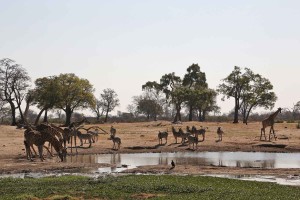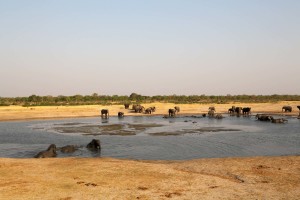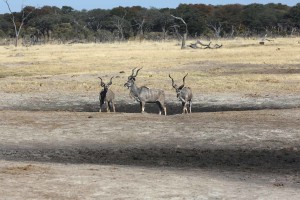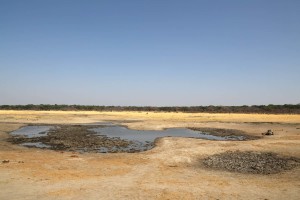
Gary loves elephants, and has a special place in his heart for them – which is just as well as much of the work he does centers around the great, grey pachyderms. He refers to them as “Our Friends” and at times when they test him severely as “Long Nosed Pigs!” This is an update from Gary received today – 27 October 2015:
“We’ve been fully busy these last two weeks repairing pipes and making sure everything that can produce water is pumping.
Manga 3 has been looked after by African Bushcamps, but has been giving trouble recently, so we went to investigate. Unfortunately we found the pan bone dry and the borehole pipe properly blocked up. We think the camp concerned fitted an engine too small to pump enough water to push out the sand and mud, so there was build up in the pipes to the point of seizing the unit at the bottom. We could not budge it until we put one of our big spanners on the pipe and turned it at the top. We fitted a larger game water engine and left it pumping well.

Our Friends destroyed the pipe at Nyamandhlovu Pan and were pulling it up and back towards the road. We replaced it with polypipe and backfilled the big gully they had created with our tractor and the blade.

Similarly at Dopi Pan, Our Friends dug up the pipe and started pulling it up towards the engine. We shut this down and replaced the pipe all the way back to the block at the pan. After we re-started the engine, a troop of baboons, eight kudu and a roan antelope bolted for the water – they had stood around patiently waiting the whole time we were working. It wasn’t long before a group of 20 ellies pitched up and charged at the kudu and baboons to chase them off, but they were having none of it. They stood firm and made the elephants wait until they had drunk their fill.
Caterpiller pan has had no problems with pipes or pumping, and a huge number of animals are drinking there. 9 lions killed a young ellie and fed on it for about 4 days. They treed the resident troop of baboons by lying in the semi shade of the tree in which the apes were roosting. When the lions moved off in the evening there was a mad scramble by the very thirsty baboons to get to the water and drink. We have had numerous reports of baby ellies caught in the trough at Caterpillar, and have seen a couple of calves trapped at Dom as well. Most times the parents manage to get them out using their trunks and feet, but in true elephant fashion non-too gently. We need to address this problem once it rains and the pressure is off.
The pipes at Jambile were pulled up at the pump, but fortunately it was switched off by the camp attendant before Our Friends wrecked it totally. We effected repairs and put railway sleepers around the engine and pipes to protect them. They also ripped off the pipe at the top of the borehole at Manga 1. We refitted and cut pipes and threads to put it back together, sorted out leaks and started the engine.
Right now we are at the most crucial stage of the season where it is absolutely imperative we keep it all together and pump everything possible. Repairs are quick and aimed at getting things working fast. Most pans are very low and full of mud, and the only drinkable water is that being pumped from underground.
The current state of the pans in our area is as follows:
Caterpiller Dopi Jambile and Manga 1: None of these have any water in the pans, but there is water in the troughs.
Nyamandhlovu and Dom: levels are very low and the water is muddy.
Guvalala is low with little drinkable water in the pan.
Shumba has muddy water in the pan and is pumping well.
Shapi has no water in the pan, but there is water in the trough.
Mabuya mabema has a small amount of water where the solar pumps it out, the rest is mud.
Tshebe tshebe has good water in the pan but it’s muddy
Livingi is reduced to a little puddle.
Makwa is still low but has water in the pan
Sinanga is very low but also has a little water in the pan
Kennedy 1 is looking good for this time of year. It went down when The Hide were unable to pump their pan due to power outage, but has recovered to a degree as the underground water is shallow and very prolific.
Kennedy 2 has water and mud in the pan
Ngweshla still has water in the pan.
Kaoshe is a natural pan and has not dried since we scooped it some years ago but is just mud now.
I spoke to Mr B, the water manager for the Wilderness Concession, and all their pans are also way down.
Hopefully we will get some respite for these animals in the next few weeks There is lots of competition for water round the pans, and some serious elephant boxing taking place. Bits of broken tusks are to be found all over. But the ellies are doing ok and only a few vulnerable ones have succumbed in the extreme heat so far.”

Thanks for news on the ground Gary – let’s hope for some rain relief very soon.